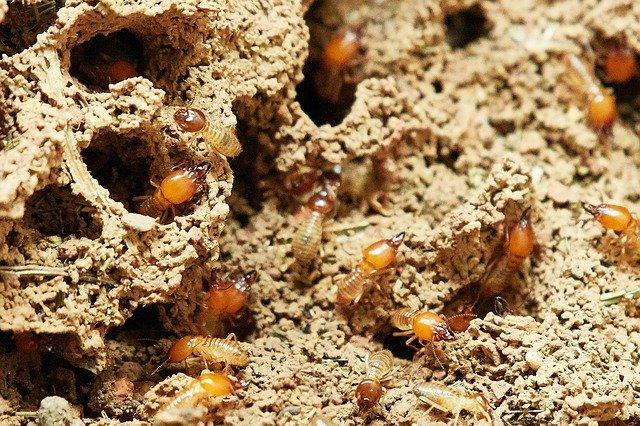
What Attracts Termite Swarms
Termites in North Carolina are a major nuisance, sometimes it even seems like homes in the Tar Heel State get the absolute worst of it. If you’re a homeowner, you’ve probably wondered what it is, exactly, that will bring termites swarming to one house but leave another untouched. Luckily, we have some answers, and some of what attracts termites may surprise you.

Why Termite Extermination and Prevention Are Important
Termites do more damage to homes in North Carolina than fires, floods, and tornadoes. They cause over 5 billion dollars in damage every single year! Safe to say that a termite infestation could be destroying your biggest investment!
Termite swarms often travel from house to house - so if your neighbor has termites, you could too!
Termite infestations spread easily. A moderate size termite colony can do damage in as little as six months and can destroy the foundation and structure of a home - even without it being visible. It takes an average of three to five years for a termite colony's damage to become visible. That's why it's important to have a termite inspection from an experienced termite control company.
If you're not sure when the last time you had an exterminator inspect your home for termite damage was, it's time to contact our exterminators in North Carolina. Termites are a common problem in West Jefferson, Lenoir, Mooresville, Blowing Rock, and Hickory, North Carolina - but not with A-1 termite exterminators!
What Attracts Termites?
Not sure what attracts termites? You need to know in order to prevent a termite infestation in your home. Inspect the following areas in and around your home to look for signs of termites. If you see sawdust, termite wings, termite eggs, termite droppings, or evidence of termites burrowing, it's time to contact our termite exterminators.
Wood
This is probably the most obvious attractant for a termite swarm on this list, but it’s a good place to start. Termites are first and foremost attracted to different kinds of wood, depending on the species.
In North Carolina, the most common kind of termite is the Eastern subterranean termite and imported Formosan subterranean termite, though you’re more likely to see the former.
These termites live in colonies underground, burrowing through the soil. So what draws them out? Breakfast, lunch, and dinner, of course. And for all three courses—and everything in between, as these destructive insects are eating 24 hours a day, seven days a week—termites feed on wood and cellulose-based materials such as paper, plants, and sheetrock.
Subterranean termites are what are known as damp wood termites. Unlike their dry wood counterparts, they are attracted to moist wood, meaning it’s easier for them to turn a house into a buffet in the middle of North Carolina’s humid climate.
Moisture
Moisture does more than just attract subterranean termites, it sustains them. That’s right, these insects can’t survive in an environment without enough moisture.
Leaky pipes, poor drainage, and limited airflow in humid spaces all create conditions perfect for termites looking to make themselves at home. This water not only hydrates them, but it is also necessary for their digestion of the cellulose in the wood and other materials they eat.
Soil
Subterranean termites live and travel in soil, making it an absolute must when it comes to attracting them.
In order to make contact with homes, they use something called “mud tubes”. These tubes, made of soil, are their main mode of transportation and are also places where they can survive comfortably. If there is no soil, there are no mud tubes, and a subterranean termite problem is virtually impossible.
Heat and Humidity
Termites thrive best in hot and humid conditions, which is why places in the Southeastern United States typically get hit the hardest when it comes to termite problems. We know for a fact that North Carolina fits this bill - just take a step outside on a toasty spring or summer day and those hot, humid conditions will speak for themselves!
While you can’t do much about our state’s high humidity averages, you can take some steps to lower that humidity in your house, and in turn, lower your risk of a termite infestation. Consider taking a closer look at your ventilation to be sure it's up to snuff, or buying a humidifier to do the job for you.
Wood in Contact with Foundation
Subterranean termites have to travel through either wood or soil, so if your home’s foundation is in contact with any wood, you’re more susceptible to termite infestation.
Think about it: if termites have to choose between traveling long distances between their home in the soil for their food, building mud tunnels and breaking a sweat, or just hopping directly into your house from wood that’s already in contact with your soil, which do you think they’d opt for? That’s right, the path of least resistance is preferred even by pests.
So, if you have things like shrubbery, firewood, or outdoor wood furniture in contact with your home's foundation, it can act as these wood-based pathways into your home for subterranean termites.
Cracks in Building Exterior
Cracks in a building's exterior are an obvious entry point for subterranean termites! These cracks present an opportunity for these insects to start building interior mud tubes, which will allow them to enter your home and maintain their comfort.
Once they make their way inside via these cracks (or gaps), they can start chowing down on the wood and other cellulose material and begin to cause structural damage. And since these guys are eating 24/7, and working in colonies that range in size from 60,000 and 1 million termites, it doesn’t take much time at all for them to do some serious damage working from the ground up.
How Common Are Termites in North Carolina?
Termites are pests common to North Carolina, which many homeowners have had to deal with. The humid climate, long hot summers, and mild short winters create ideal circumstances for termites to flourish.
North Carolina residents aren’t alone, though. In the United States, termites cause more damage to homes than fires, tornadoes, and hurricanes combined. That doesn’t mean that termites are unavoidable. With proper identification and annual termite inspections done by a trusted exterminator, you can avoid the devastation that these insects can do to your home.
What Keeps Termites Away?
So you know what draws termites in, but how do you keep them out? There are some general guidelines you should keep in mind to help lower your risk of termite infestation in North Carolina, as well as some tried-and-true treatments we recommend for every homeowner in NC.
Avoid Mulch
While mulch is a popular pick among landscapers for its aesthetic appeal and low-maintenance advantages, it’s also popular fodder for termites. Mulch retains moisture, and protects insects against harsh temperatures—two things that attract these wood-eating pests.
If you absolutely must have mulch, make sure it isn’t in contact with the foundation of the house or any wooden window or door frames.
Reduce Humidity
You can’t control the humidity outside in North Carolina summers, but you can take steps to reduce it inside your home. Adding a dehumidifier to rooms in your house that are particularly damp, and pay special attention to your crawlspace, where excess moisture can compromise the structural integrity of your home, foster mold, and attract termites.
To really get ahead of the issue, consider crawl space encapsulation. At A-1 Pest Control, our team uses the best in tools and techniques to seal your crawl space with reinforced polyethylene liner, double-check every opening to be sure moisture can’t sneak in, then add a Santa-Fe dehumidifier to keep the humidity at bay.
Keep Wood Away From Soil
The closer the wood elements of your house are to the soil, the easier it is for termites to get straight from the ground to your home.
Keep wood siding, door frames, and any other potential termite food at least six inches above the soil, to avoid making it too easy for them to get in.
You should also make sure any firewood, wooden furniture, and plants with branches and trunks are a good distance away from the house itself. If they aren’t, termites can easily make it from the soil, to the wood of the intermediary, to your home.
Termite Treatments
There are also plenty of technologies and treatments on the market today that can successfully prevent or get rid of termites. At A-1 Pest Control, we offer our North Carolina customers the best in the form of Sentricon and Termidor.
Sentricon is one of the most popular termite extermination systems because of its affordable, flat rate and proven effectiveness. Our team is made up of professionals who are Authorized Operators of the system, which involves strategically and safely placing in-ground bait stations around your home in the areas most affected by termites. These traps are then monitored with a yearly inspection, to ensure your home stays sound for years to come.
Termidor is another one of the most effective termite control options available. The liquid treatment is applied along your home's foundation, creating a barrier. When termites pass through or eat through the barrier, it begins to take effect.
If you’re not sure which system, if any, is right for you, A-1 Pest Control can send an expert out for a free pest control home inspection.
Signs of a Termite Infestation
How do you know if you have termites in your home? There are a few tell-tale signs to be on the lookout for:
- Drooping drywall
- Peeling paint
- Hollow sounds when knocking on wood
- Pinpoint-sized holes in drywall
- Buckling floors
- Crumbling wood
- Piles of wings (resembling fish scales) on windowsills
- Termite droppings
- Mud tubes
Plus, if you see any termite swarms—groups of flying termites that usually occur in spring and summer, and around dusk—you can assume there are more where that came from.
A-1 Pest Control Termite Solutions
If you need to get rid of termites, A-1 can help. First, let us see if you have a termite issue by completing a thorough inspection. we’ll complete a thorough inspection of your property to identify if there is existing termite activity, assess the severity of the infestation and amount of termite damage, and identify any termite-conducive conditions and provide you with a termite control quote. Get in touch with us right away and get your termite control estimate today!
